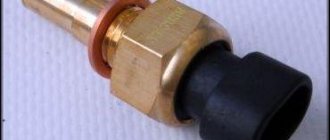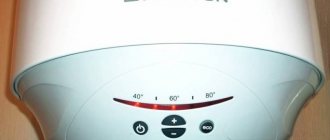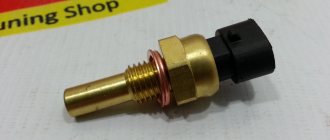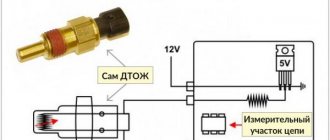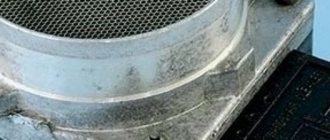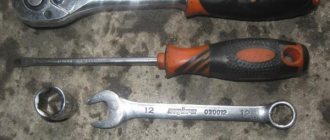The normal operating temperature of the engine on the instrument panel is 90 degrees. The arrow indicates the red zone of engine overheating. Learn more about the situation when the instrument panel does not show the engine temperature.
You can find out why the malfunction occurred in your garage, and you don’t have to go to a car service center. But to fix the problem, you may need outside help from professionals.
So, let's look at the main reasons why the temperature arrow on the VAZ-2114 dashboard goes up:
- Dashboard diagram.
- Temperature sensor.
- Wiring harness.
- ECU.
Solution methods
When the reasons are identified, you can proceed directly to eliminating them and consider the issue in more detail. So, to begin with, it is worth noting that the motorist will need some knowledge of the design features of the car, as well as knowledge of the electrical part.
Dashboard diagram
Dashboard board
The first place to look for a problem is the dashboard. In order to eliminate the malfunction, you will have to dismantle the “tidy” and also disassemble it.
The next step is to find the motor that powers the arrow. There may be two malfunctions here. Which ones exactly:
- Due to a short circuit, the motor winding burned out.
- The wire that is soldered from the motor to the dashboard board has come unsoldered or has come off.
To eliminate this cause, it is necessary to inspect the place and determine the presence of breaks. For complete reliability, it is necessary to ring the contact wires of the motor that close the winding.
Another stage of diagnostics will be the connector that connects to the board . It is necessary to find the contact that is responsible for the temperature indicator and also ring it using a multimeter. If a connection break is detected, it must be repaired.
Attention! If a motorist does not have experience in repairing such components, it is strongly recommended to contact professional auto electricians so as not to cause even more trouble when doing the repairs yourself. They will do everything quickly and efficiently.
temperature sensor
The temperature sensor is checked with a multimeter
If the problem was not hidden in the dashboard, then you need to contact the temperature sensor directly . It is this that serves as an indicator of the engine temperature and transmits data through the computer to the needle. Failure of the product can cause a freezing effect and the needle on the dashboard going off scale.
To determine the functionality of the sensor, it must be dismantled and “ringed” using a multimeter. If it is determined to be “dead”, then it must be replaced.
Wiring harness
Disconnecting the wiring harness from the instrument panel for inspection
If the first two reasons are eliminated, but the problem remains, then you should look for the problem in the wiring harness that goes from the engine to the dashboard. Of course, not all motorists are able to cope with this type of diagnosis, due to ignorance of wire pinout. Therefore, in this case, it is also worth contacting professional auto electricians to find out the causes and repair. Although, the reason here is quite simple and understandable - a wire break or burnout.
List of ECU errors
It is not often that the problem of the needle leaving its normal position can be caused by an electronic control unit. It is he who sets all the parameters and signals on the dashboard.
To troubleshoot the problem, you need to connect to it and check for errors related to the temperature sensor and cooling system. Thus, a simple reset of errors can lead to normal operation of the device.
Why the temperature arrow goes off scale - the main reasons!
The normal operating temperature of the engine on the instrument panel is 90 degrees. The arrow indicates the red zone of engine overheating. Learn more about the situation when the instrument panel does not show the engine temperature.
You can find out why the malfunction occurred in your garage, and you don’t have to go to a car service center. But to fix the problem, you may need outside help from professionals.
So, let's look at the main reasons why the temperature arrow on the VAZ-2114 dashboard goes up:
Solution methods
When the reasons are identified, you can proceed directly to eliminating them and consider the issue in more detail. So, to begin with, it is worth noting that the motorist will need some knowledge of the design features of the car, as well as knowledge of the electrical part.
Dashboard diagram
Dashboard board
The first place to look for a problem is the dashboard. In order to eliminate the malfunction, you will have to dismantle the “tidy” and also disassemble it.
The next step is to find the motor that powers the arrow. There may be two malfunctions here. Which ones exactly:
To eliminate this cause, it is necessary to inspect the place and determine the presence of breaks. For complete reliability, it is necessary to ring the contact wires of the motor that close the winding.
Another stage of diagnostics will be the connector that connects to the board . It is necessary to find the contact that is responsible for the temperature indicator and also ring it using a multimeter. If a connection break is detected, it must be repaired.
Attention! If a motorist does not have experience in repairing such components, it is strongly recommended to contact professional auto electricians so as not to cause even more trouble when doing the repairs yourself. They will do everything quickly and efficiently.
temperature sensor
The temperature sensor is checked with a multimeter
To determine the functionality of the sensor, it must be dismantled and “ringed” using a multimeter. If it is determined to be “dead”, then it must be replaced.
Wiring harness
Disconnecting the wiring harness from the instrument panel for inspection
If the first two reasons are eliminated, but the problem remains, then you should look for the problem in the wiring harness that goes from the engine to the dashboard. Of course, not all motorists are able to cope with this type of diagnosis, due to ignorance of wire pinout. Therefore, in this case, it is also worth contacting professional auto electricians to find out the causes and repair. Although, the reason here is quite simple and understandable - a wire break or burnout.
It is not often that the problem of the needle leaving its normal position can be caused by an electronic control unit. It is he who sets all the parameters and signals on the dashboard.
To troubleshoot the problem, you need to connect to it and check for errors related to the temperature sensor and cooling system.
Thus, a simple reset of errors can lead to normal operation of the device.
Why does the engine temperature drop while driving?
But the problem has not gone away, and everything here has even become warmer, but the problem remains. Further interesting, no matter where I went, everyone said the same thing - thermostat!
At speed, the engine temperature drops. Note that a decrease in the temperature of the internal combustion engine while driving can also occur naturally and not be a consequence of any malfunction.
This usually manifests itself in the cold season, that is, during frosts. On many cars, when driving on the highway, the engine temperature drops, since the engine temperature drops when the Chevrolet Lacetti is driving and the front part of the engine compartment is open to blowing by oncoming air. This mode can be considered the most economical, that is, the minimum amount of fuel burns in the cylinders.
For ease of understanding, the lower the speed and the less fuel burned in the cylinders, the less heat the engine has.
Do not forget that in winter the driver constantly uses the stove in the cabin, which additionally takes away heat. This phenomenon is typical for entry-level and middle-class cars, which are often equipped with low-volume internal combustion engines and do not have additional hood insulation.
What is the operating temperature of the Lacetti 1.6?
It is also worth noting that many diesel engines do not heat up well at idle and can cool down noticeably while driving. It is especially noticeable on small cars and models equipped with medium-sized engines.
The situation is also typical for diesel engines, which not only do not warm up well at idle, but also cool down quickly when driving with insufficient intensity. The car heater has a special radiator, which is included in the general operating circuit of the cooling system. When the driver turns on the interior heating, antifreeze passes through it, giving off some of the heat.
Engine temperature drops when driving
The amount that will be given depends on the set temperature of the heater and its operating mode. The higher these indicators are, the more the interior of the car will heat up. If the engine operates at low speeds, and is also used in winter, there may simply not be enough heat to fully warm up the coolant.
Is it possible to slow down the drop in engine temperature when driving a Chevrolet Lacetti engine in cold weather? In the past, different materials were used to create engine insulation. These are the different felt fabrics available in circulation. But such decisions did not keep the heat for long. Modern thermal insulating car blankets are now used. Their composition prevents ignition, which has a positive effect on the safety of vehicle operation.
Also, numerous engine warm-ups will not be required.
This will save time and fuel. When the weather conditions are too harsh, such techniques will be able to retain heat in a short period of time. It is possible to use special covers for the radiator.
Its lower part, together with the pipe, must be thermally insulated in order to maintain a stable temperature of the running engine.
Actions to prepare the cooling system for winter The winter period of operation is difficult for all vehicle owners. Preparatory work will help you be fully prepared. Discussion closed by moderator Lexona The thermostat is located at the coolant outlet from the head, the coolant temperature is maximum here.
Why does the temperature needle jump on a VAZ 2114?
The VDO instrument panel does not work. Temperature and fuel levels are “buggy”
Incorrect temperature and fuel readings? Probably many owners of VAZ 2110 - 2115 have already encountered the problem of incorrect display of fuel and temperature indicator on the dashboards of VDO, “Schetmash” Kursk, “Avtopribor” Vladimir.
The actual engine temperature is 90 degrees (we know this for sure), but on the instrument panel it shows 110 degrees. There are 10 liters of gasoline in the tank, but the instrument panel shows either 20 liters, then 15 liters, and sometimes correctly 10 liters. Moreover, usually the tachometer and speed always show the correct values. I had this problem for about a whole year. When I test the instrument panel (Press the daily mileage button - hold it down, turn on the ignition, all the arrows of the instrument indicators are observed to deviate over the entire span of the scale and the LCD segments are completely filled, and the emergency fuel level warning lamp also lights up. When testing the instrument panel, the temperature indicator should smoothly go a distance from 50 degrees to 130 degrees. The fuel level should smoothly go a distance from 0 to 1). If the pointers work correctly during the test, then the problem is electronics. Car service centers say that these instrument panels cannot be repaired. Just buy a new one of the same instrument panel and everything will be fine. It was a pity to spend money on a new VDO instrument panel (about 2,400 rubles), since the engine speed and speed of the car were shown, the temperature was monitored on the STATE 510 trip computer, and when refueling I had to set the gasoline in the same way on the standard computer. It was read theoretically from the controller. By the way, the calculation was quite accurate, but it was annoying to constantly put out gasoline.
By the way, here is another main feature that confused me, the fact is that the temperature gauge began to jump strongly when the car’s lights, low beam, etc. were turned on.
Recently I decided to tackle this problem and fully understand it. I didn’t really believe that it was an electronics failure. The solution turned out to be very simple. In fact, it was just necessary to bring a good “ground” to the instrument panel. Or just restore the default one. After all the tightening of the “ground”, the instrument panel began to work correctly. The temperature and fuel gauges now work accurately, even with the lights, heaters, etc. on.
Engine temperature arrow goes off scale VAZ 2110 what to do
- Registration
- Entrance
- To the beginning of the forum
- Forum Rules
- Old design
- FAQ
- Search
- Users
When you turn on the ignition, the needle goes off scale well beyond the red zone. Moreover, on a cold engine this does not happen immediately, but after a few seconds. Where to “dig”?
These are different sensors. Judging by what you wrote, you have an injector. And you tore off the two-pin sensor, which is near the thermostat. When there is a malfunction (the connector is pulled out), the ECU turns on the fan. And there is another sensor on the instrument panel, it is in the head of the block at the end of the engine below the thermostat (like a carburetor), one wire goes to it. Watch it.
can be more. I mean, how to find the sensor - there are a ton of them, at first I thought about one - it turned out to be a knock sensor
If you look at the engine, then on the right side there is such a pipe with a rubber cover sticking out, and a wire is put on it. True, this is how it is on my carb, in theory it should be like this on the engineer too.
_________________21093 95 onwards (bucket) —> 2108 87 onwards (Wrx sti)
I had the same problem. The sensor flew into the red zone and very rarely showed the correct value. The technicians took a look and told me to change the panel assembly. I installed the 15th VDO panel - now I’m enjoying myself)
Source
Is the thermostat to blame?
Forum participants often ask: why does the engine temperature gauge needle jump? Before answering, you should clarify the formulation of the question itself. Changing instrument readings do not necessarily mean that the engine temperature is fluctuating.
For example, the needle swings in a sector from 70 to 90 degrees or oscillates chaotically with a large amplitude. But heated coolant (coolant) has thermal inertia and cannot change its parameters so sharply. It follows that the instrument readings may not reflect the actual temperature of the internal combustion engine (ICE).
If the readings change rather slowly, we can assume that they show the actual degree of heating of the motor. In this case, it is necessary to critically assess the situation: are temperature fluctuations really dangerous? When they occur in the range of 90 to 105°C, there is no cause for alarm, since this is the normal operating temperature that the thermostat maintains.
Now, if smooth fluctuations go beyond this range, then you should look for the reasons for the violation of the thermal balance. The thermostat may be the culprit. But this still needs to be verified.
The easiest way is to try heating the supply pipes to the radiator by touch. The suspicion is confirmed when the lower pipe is slightly colder than the top. This means that the thermostat control valve is stuck open and the engine is running underheated. A similar thermostat malfunction is usually encountered after 70 thousand kilometers.
The engine temperature arrow jumps, floats or jumps: causes and main malfunctions
So, normally the needle should rise to a certain value after the internal combustion engine has completely warmed up and not deviate from its occupied position. Note that during driving, small deviations are quite acceptable, and often to a lesser extent.
This phenomenon usually occurs in the cold season, often when driving on the highway. This is explained by the fact that in cold weather the engine is intensively cooled at high speed by counter flows of cold air.
Also, the heater takes away some of the heat from the engine in winter. As a result, the arrow may “fall” a little (by 2-3 mm from normal values). If you reduce the speed or allow the car to run at idle for several minutes, then the temperature gauge will rise to normal.
If we talk about problems, there should not be any obvious jumps in the temperature indicator. In cases where the temperature gauge needle floats, if there is a digital “stick” indication, the temperatures are constantly changing, then this serves as the main symptom of various problems. Let's figure it out.
- First, in order to understand why the engine temperature gauge needle jumps, it should be taken into account that changing readings on the indicator do not always mean that in reality such significant changes in the temperature of the internal combustion engine occur.
In other words, a change in readings within the average range of 75-95 degrees does not reflect the actual picture, since heated coolant (antifreeze, antifreeze) cannot heat up and cool down so quickly. It turns out that the indicator does not display the actual engine temperature.
Otherwise, a smooth change in readings can be taken as the norm, making allowances for the conventional error of the dial or digital indicator itself. Moreover, if temperature fluctuations do not exceed acceptable limits, it is likely that this is the operating temperature of the engine.
A cause for concern is chaotic, usually sharp fluctuations of the needle, and the amplitude of such fluctuations is quite large. In this situation, it is necessary to determine whether there really is a violation of the thermal balance, whether the indicator itself is working normally, and also for what reasons the malfunction occurred.
- So, let's go. If the system is sealed and the coolant level in the expansion tank is normal, then the most frequently failing element, on which the engine temperature directly depends, is the cooling system thermostat. Moreover, this device often fails even on completely new cars with minimal mileage. So it’s better to start checking with the thermostat.
The simplest method of initial diagnosis is to assess the degree of heating of the supply pipes going to the radiator. It is enough to touch the pipes with your hand. If the lower hose is colder than the upper hose, it is likely that the thermostat valve is stuck. As a result, even on a cold internal combustion engine, the coolant enters a large circle, and the engine cannot reach operating temperatures.
In practice, this manifests itself as follows: when the driver first warms up the engine, the temperature needle rises to operating temperatures, then the thermostat opens. Next, the coolant flows in a large circle, the engine temperature decreases, but then the thermostat jams and does not close completely.
Naturally, the liquid continues to flow partially or completely through the radiator (in a large circle). As a result, the engine begins to cool down and the temperature gauge drops. Then the thermostat will either close, after which the coolant will heat up to operating temperatures, or it will remain stuck in the jammed position and the engine will not warm up completely.
In this case, often after stopping the engine and the pressure in the cooling system drops, the needle will first rise to normal temperatures as it warms up, but then after the thermostat opens, everything will repeat again. There are also cases when the thermostat may not jam constantly, but every once in a while, and may not allow coolant access to a large circle.
In this case, the engine will overheat. It happens that the operation of the thermostat is disrupted both in opening and closing, that is, it is appropriate to talk about a combination of problems. One way or another, you need to make sure that the thermostat is working properly and normally.
- Now let's look at a situation where the engine temperature needle is jumping, but the thermostat and other elements of the cooling system are fine. In this case, the problem may be in the coolant temperature sensor (DTOZH). It turns out that if the temperature needle jumps, the culprit is often an incorrect signal from the temperature sensor.
This means that the specified sensor needs to be checked. It is important to take into account that many cars may have 2, 3 or even 4 such sensors. These sensors are also located in different places depending on the design of a particular internal combustion engine.
Also, a separate sensor sends a signal to the instrument panel so that its readings in the event of failure do not change the operation of the ECM and engine ECU. Having found the desired temperature sensor, you need to check its contact. It is enough to move the sensor or the terminal chip on it.
At this time, the assistant must monitor whether the temperature indicator on the instrument panel in the car interior fluctuates. Often, poor contact causes the temperature needle to fluctuate, while the cooling system works normally.
We also recommend reading the article about why engine temperature drops while driving. From this article you will learn about the possible reasons why the temperature gauge needle drops while driving.
If the problem is not in contact, the sensor itself may be faulty. To check this, you should measure the resistance at different coolant temperatures. To do this, you need to know what resistance is considered normal for a sensor on one or another internal combustion engine under certain conditions.
This information can be found on specialized forums, in technical literature, etc. We also note that you should not immediately and hastily attribute all problems to the thermostat without checking the temperature sensors. The arrow can jump and jump if the contact points on the sensor are simply oxidized or the connection is loose. Moreover, surges can only occur when powerful energy consumers are turned on (heated seats, windows, headlights, etc.).
Let us also add that if the sensor itself malfunctions, the readings usually change within a certain range. If they change chaotically, then most likely there are problems with the wiring. Often the culprit is negative contact.
There have been cases when, due to problems with the “ground,” the temperature gauge showed critical overheating, and after stopping the engine, the normal 90 degrees. At the same time, measurements at the battery terminals with the engine turned off were about 12.5, after starting they rose to 13.7 V.
However, neither replacing the battery with temperature sensors nor diagnosing and checking the generator solved the problem. The way out of this situation was an additional “minus removal” of the engine.
Or maybe it's the sensor?
When the temperature needle moves, it only follows the changing signal that comes from the temperature sensor. It follows that if the latter is lying, then the pointer shows incorrect information. Therefore, when the pointer on the dashboard begins to misbehave, making sudden movements, you must first check the sensor.
Attention: modern internal combustion engines are equipped with 2 to 4 temperature sensors. Their installation locations may differ on different cars.
Usually there is a separate sensor on the shield so that it does not introduce an error into the operation of the electronic control system (ECU). After it is found, you should make sure that there is a contact at the connecting terminal. Rock it slightly, and let a friend watch the behavior of the arrow. Sometimes the reason is extremely simple - a loose connection or an oily terminal.
If the contact is normal, you should check the functionality of the sensor itself. To do this, use a portable ohmmeter, which measures the resistance of the element being tested at different temperatures. These values are taken from the table contained in the product documentation.
As an example, a few lines from the passport data of the coolant temperature sensor (DTOZH) 23.3828
| Temperature, °C | Resistance, Ohm |
| 100 | 177 |
| 80 | 330 |
| 50 | 975 |
| 20 | 3520 |
| 9420 | |
| -10 | 16180 |
| -20 | 28680 |
Sometimes the driver is so fixated on the supposed malfunction of the thermostat that he long and persistently strives to replace it under warranty. When his efforts reach their goal, it turns out that everything remains the same. And only after replacing the temperature sensors does the indicator return to normal.
I have contact
As electricians say, there can only be two faults: there is no contact where needed, or there is contact where it is not needed. This rule also applies in the situation under consideration. The arrow will jump if the joints are oxidized or weakened. Moreover, most often this happens when additional consumers are connected: low beam, headlights, etc.
As mentioned above, the first thing to do when diagnosing DTOZH is to check the contact in the connector. Returning to the previous section, the following should be added: if the sensor malfunctions, the readings fluctuate within the same range, and if they change chaotically, the wiring may be damaged. How important the negative contact is - the mass - will be confirmed by one case described by a forum participant.
The gauge needle sometimes jumped to 130°C. After stopping the engine, it showed the correct result - 90°. The voltage at the battery terminals when the engine was not running was about 12.5 V, and after starting it rose to 13.7.
Soldering iron in your hands
Do not forget that the thermostat, the DTOZH, and the wiring may be in good working order, but the temperature gauge still works abnormally, and its behavior is unpredictable. Here, most likely, the culprit is the electronic board of the instrument panel (“brains”). There are a lot of complaints from drivers about this unit.
The fact is that the component base is obviously not soldered very well. After several years of operation, the solder joints oxidize and the control unit begins to “glitch.” The best solution is to dismantle the instrument panel and carefully resolder all elements.
Particular attention should be paid to soldering resistors and output ground. Along the way, you will acquire radio engineering skills. The soldering iron should have a thin tip and low power. Of course, opening the front panel is not an easy task, and such repairs should be done as a last resort.
Attention - air
Finally, another possible reason for sudden movements of the needle is the presence of air bubbles in the antifreeze (“airing” of the system). Since the air and antifreeze have different temperatures, the needle jerks. An indirect sign of this malfunction is the splashing of coolant from the radiator cap or expansion tank, as well as a decrease in the filling volume.
To summarize, we can suggest the following order for checking the elements: contacts, ground, temperature sensor (DTOZH), thermostat, indicator board. Owners of Renault Logan should not dramatize the 2-4-2 display. This is normal thermostat operation.
PS In order not to upset Logan drivers, on the Duster and the second generation Logan-Sandero the temperature indicator on the dashboard was completely removed. As they say: no pointer, no problem.
Source
Is the thermostat to blame?
Forum participants often ask: why does the engine temperature gauge needle jump? Before answering, you should clarify the formulation of the question itself. Changing instrument readings do not necessarily mean that the engine temperature is fluctuating.
For example, the needle swings in a sector from 70 to 90 degrees or oscillates chaotically with a large amplitude. But heated coolant (coolant) has thermal inertia and cannot change its parameters so sharply. It follows that the instrument readings may not reflect the actual temperature of the internal combustion engine (ICE).
If the readings change rather slowly, we can assume that they show the actual degree of heating of the motor. In this case, it is necessary to critically assess the situation: are temperature fluctuations really dangerous? When they occur in the range of 90 to 105°C, there is no cause for alarm, since this is the normal operating temperature that the thermostat maintains.
Now, if smooth fluctuations go beyond this range, then you should look for the reasons for the violation of the thermal balance. The thermostat may be the culprit. But this still needs to be verified.
The easiest way is to try heating the supply pipes to the radiator by touch. The suspicion is confirmed when the lower pipe is slightly colder than the top. This means that the thermostat control valve is stuck open and the engine is running underheated. A similar thermostat malfunction is usually encountered after 70 thousand kilometers.
Pipes
Dirty engine radiator
Dirt and rupture of the SOD pipe can lead to a change in the operating temperature of the motor
The cooling system pipes can directly affect the temperature increase in the system. This is due to the fact that if cracks or delaminations form in them, it may happen that the coolant begins to leak out. In turn, the lack of “cooling” will lead to an increase in temperature, which can affect both the operation of the main power unit and increased wear.
How to remove the coolant temperature sensor from a VAZ 2114?
First, you need to pay attention to the fact that the power unit of the car model in question usually operates at a temperature of 80-90 degrees. This is the ideal temperature, but variations are possible depending on certain factors. If the engine heats up for a long time or quickly, then the problems need to be solved. So, to replace you will need to do the following:
At the next stage, you need to find the temperature sensor, remember its location and remove it using the 21 key. Next, you need to install a new device with the corresponding marking. The sensor should be in the same position as its predecessor.
For a quality connection, it is recommended to apply heat sealant to the threads. After this, all that remains is to add coolant. Then you need to start the car and look at the VAZ 2114 coolant temperature indicator sensor , making sure that the system is functioning normally.
Unfortunately, after all the operations performed, the device does not always work as expected. It is recommended to ensure that the new sensor is installed correctly. Sometimes motorists forget to add fluid to the system. But there are also situations when the product turns out to be defective. The car may be unstable. Therefore, if replacing the sensor on your own does not bring the desired result, the car owner has only one thing left - contacting a trusted car service center.
What is the operating temperature of the 8 valve VAZ-2114 engine
Many experienced and not so experienced car enthusiasts have encountered the fact that when operating a VAZ-2114, the engine may not warm up to the required operating temperature or may overheat. This is due to changes in the operating temperature inside the engine or some malfunctions that periodically occur in any car. The article will tell you what the operating temperature of the engine is, and will also tell you about the causes of malfunctions associated with this indicator.
Or maybe it's the sensor?
When the temperature needle moves, it only follows the changing signal that comes from the temperature sensor. It follows that if the latter is lying, then the pointer shows incorrect information. Therefore, when the pointer on the dashboard begins to misbehave, making sudden movements, you must first check the sensor.
Attention: modern internal combustion engines are equipped with 2 to 4 temperature sensors. Their installation locations may differ on different cars.
Usually there is a separate sensor on the shield so that it does not introduce an error into the operation of the electronic control system (ECU). After it is found, you should make sure that there is a contact at the connecting terminal. Rock it slightly, and let a friend watch the behavior of the arrow. Sometimes the reason is extremely simple - a loose connection or an oily terminal.
If the contact is normal, you should check the functionality of the sensor itself. To do this, use a portable ohmmeter, which measures the resistance of the element being tested at different temperatures. These values are taken from the table contained in the product documentation.
Methods for checking DTOZH on a VAZ 2114
If the car owner observes the manifestation of the above symptoms, then they may indicate a breakdown of the device. But before making a replacement, it is necessary to perform a check. There are 2 methods used for this. To check using the first method, you will need to do the following:
The second method allows you to check the coolant temperature sensor using a multimeter and thermometer. A thermometer will be needed to measure up to 110 degrees.
The test comes down to measuring the resistance. Therefore, the multimeter must be switched to ohmmeter mode. Next, the coolant should be poured into a special container that will be resistant to elevated temperatures. The sensor must be placed in a container with coolant and gradually heated. The multimeter probes must first be connected to the sensor contacts and the housing. In this case, the motorist will need to monitor changes in resistance and temperature. Below is a table whose values correspond to the standards.
The method under consideration makes it possible to fairly accurately determine the functionality of the device. This is the method that is often used to test a new sensor. But it has a significant drawback, since the device must first be dismantled. Let us dwell on this issue in detail.
Fan sensor
A fan, which provides additional air flow, cooling a running engine, is installed on almost all cars. A sensor (meter) is responsible for the proper functioning of our fan, which turns it on when a certain coolant temperature is reached. This meter is a consumable item and needs to be replaced periodically. We will need a tool:
- Screwdriver Set
- new sensor to replace
- spanners
- coolant drain container
We make a replacement
Replacement is easy to do yourself. We carry out the work on a cold (cooled) engine. So:
- First, drain the coolant from the radiator.
- Then disconnect the negative wire terminal from the battery
- Disconnect the wires from the electric fan sensor
Disconnect the wires from the meter
- We unscrew the sensor using the key to “30”
Remove the meter with a key set to “30”
The sensor can be replaced without draining the coolant:
- To do this, close the generator with a plastic bag, loosen the sensor using a key to “30”
- Having prepared the new sensor, very quickly unscrew the old one and immediately screw in the new one
- If you do everything quickly, the loss of coolant is minimal.
- Installation is carried out in reverse order
- Fill coolant to the required level
- To check the sensor, we connect a tester to its contacts and lower the meter itself (more precisely, its threaded part) into a container with coolant
- We heat the container, carefully monitor the temperature of the opening and closing of the contacts using a thermometer, which we immerse in the same container with coolant (water is also suitable for checking)
That's all, if necessary, you can do this work yourself, you can also watch the video.
To identify a malfunction, experienced technicians do the following:
- They start checking with fuses, replace the burnt ones, and this can solve the problem;
- Inspection for external damage (melted plastic, insulation, chips)
- Remove the terminal by unfastening the latch and clean the contacts. If the problem is in them, then the operation of the motor will stabilize;
- Check the power circuit with a multimeter; lack of power will mean a wire break;
- Removing and checking the DTOZH;
I have contact
As electricians say, there can only be two faults: there is no contact where needed, or there is contact where it is not needed. This rule also applies in the situation under consideration. The arrow will jump if the joints are oxidized or weakened. Moreover, most often this happens when additional consumers are connected: low beam, headlights, etc.
As mentioned above, the first thing to do when diagnosing DTOZH is to check the contact in the connector. Returning to the previous section, the following should be added: if the sensor malfunctions, the readings fluctuate within the same range, and if they change chaotically, the wiring may be damaged. How important the negative contact is - the mass - will be confirmed by one case described by a forum participant.
The gauge needle sometimes jumped to 130°C. After stopping the engine, it showed the correct result - 90°. The voltage at the battery terminals when the engine was not running was about 12.5 V, and after starting it rose to 13.7.
After a year and a half of unsuccessfully searching for the cause, replacing the battery, alternator and two temperature sensors, I came across one grandpa who installed an additional ground wire from the engine to the body, and the problem was solved.
Soldering iron in your hands
Do not forget that the thermostat, the DTOZH, and the wiring may be in good working order, but the temperature gauge still works abnormally, and its behavior is unpredictable. Here, most likely, the culprit is the electronic board of the instrument panel (“brains”). There are a lot of complaints from drivers about this unit.
The fact is that the component base is obviously not soldered very well. After several years of operation, the solder joints oxidize and the control unit begins to “glitch.” The best solution is to dismantle the instrument panel and carefully resolder all elements.
Particular attention should be paid to soldering resistors and output ground. Along the way, you will acquire radio engineering skills. The soldering iron should have a thin tip and low power. Of course, opening the front panel is not an easy task, and such repairs should be done as a last resort.
The temperature needle jumps when the thermostat and DTOZh are working
In some cases, it happens that the thermostat, as well as the temperature sensor and wiring, turn out to be working. In this case, the temperature arrow jumps arbitrarily, overestimating or underestimating the readings, in an arbitrary range.
Often the problem lies in the electronic board of the instrument panel. If the soldering of such a board turns out to be of poor quality, problems arise after a few years. The malfunction can be eliminated by disassembling the shield and re-soldering. As part of such work, special attention should be paid to resistors and output mass. If you plan to do the work yourself, you need to have a low-power soldering iron with a thin rod.
We also note that the needle, with other elements in good working order, both mechanically and electrically, can jump if the engine cooling system is airy. In other words, the air in the cooling system forms an air lock. This plug heats up much faster and more strongly than antifreeze or antifreeze.
As a result, the sensor reacts to changes in temperature, the pointer arrow changes position chaotically. At the same time, the air in the system is indirectly indicated by the fact that liquid is leaking from under the cap of the expansion tank, there may be a noticeable decrease in the level in the tank, etc.
Attention - air
Finally, another possible reason for sudden movements of the needle is the presence of air bubbles in the antifreeze (“airing” of the system). Since the air and antifreeze have different temperatures, the needle jerks. An indirect sign of this malfunction is the splashing of coolant from the radiator cap or expansion tank, as well as a decrease in the filling volume.
To summarize, we can suggest the following order for checking the elements: contacts, ground, temperature sensor (DTOZH), thermostat, indicator board. Owners of Renault Logan should not dramatize the 2-4-2 display. This is normal thermostat operation.
PS In order not to upset Logan drivers, on the Duster and the second generation Logan-Sandero the temperature indicator on the dashboard was completely removed. As they say: no pointer, no problem.
Why the temperature arrow goes off scale - the main reasons!
The normal operating temperature of the engine on the instrument panel is 90 degrees. The arrow indicates the red zone of engine overheating. Learn more about the situation when the instrument panel does not show the engine temperature.
You can find out why the malfunction occurred in your garage, and you don’t have to go to a car service center. But to fix the problem, you may need outside help from professionals.
So, let's look at the main reasons why the temperature arrow on the VAZ-2114 dashboard goes up:
Solution methods
When the reasons are identified, you can proceed directly to eliminating them and consider the issue in more detail. So, to begin with, it is worth noting that the motorist will need some knowledge of the design features of the car, as well as knowledge of the electrical part.
Dashboard diagram
Dashboard board
The first place to look for a problem is the dashboard. In order to eliminate the malfunction, you will have to dismantle the “tidy” and also disassemble it.
The next step is to find the motor that powers the arrow. There may be two malfunctions here. Which ones exactly:
To eliminate this cause, it is necessary to inspect the place and determine the presence of breaks. For complete reliability, it is necessary to ring the contact wires of the motor that close the winding.
Another stage of diagnostics will be the connector that connects to the board . It is necessary to find the contact that is responsible for the temperature indicator and also ring it using a multimeter. If a connection break is detected, it must be repaired.
Attention! If a motorist does not have experience in repairing such components, it is strongly recommended to contact professional auto electricians so as not to cause even more trouble when doing the repairs yourself. They will do everything quickly and efficiently.
temperature sensor
The temperature sensor is checked with a multimeter
To determine the functionality of the sensor, it must be dismantled and “ringed” using a multimeter. If it is determined to be “dead”, then it must be replaced.
3) Thermostat malfunction
The most likely cause of a car overheating at high speeds is a faulty thermostat. If you are driving at high speed, then the load on the car engine increases, that is, at this moment it is much greater than when the car is moving at low speed.
Due to the increased load, the car engine needs more cooling. To do this, the cooling system itself, when driving at high speed, supplies more coolant to the cooling system, thereby cooling the car’s engine. This process is precisely regulated by a thermostat, which can periodically fail.
